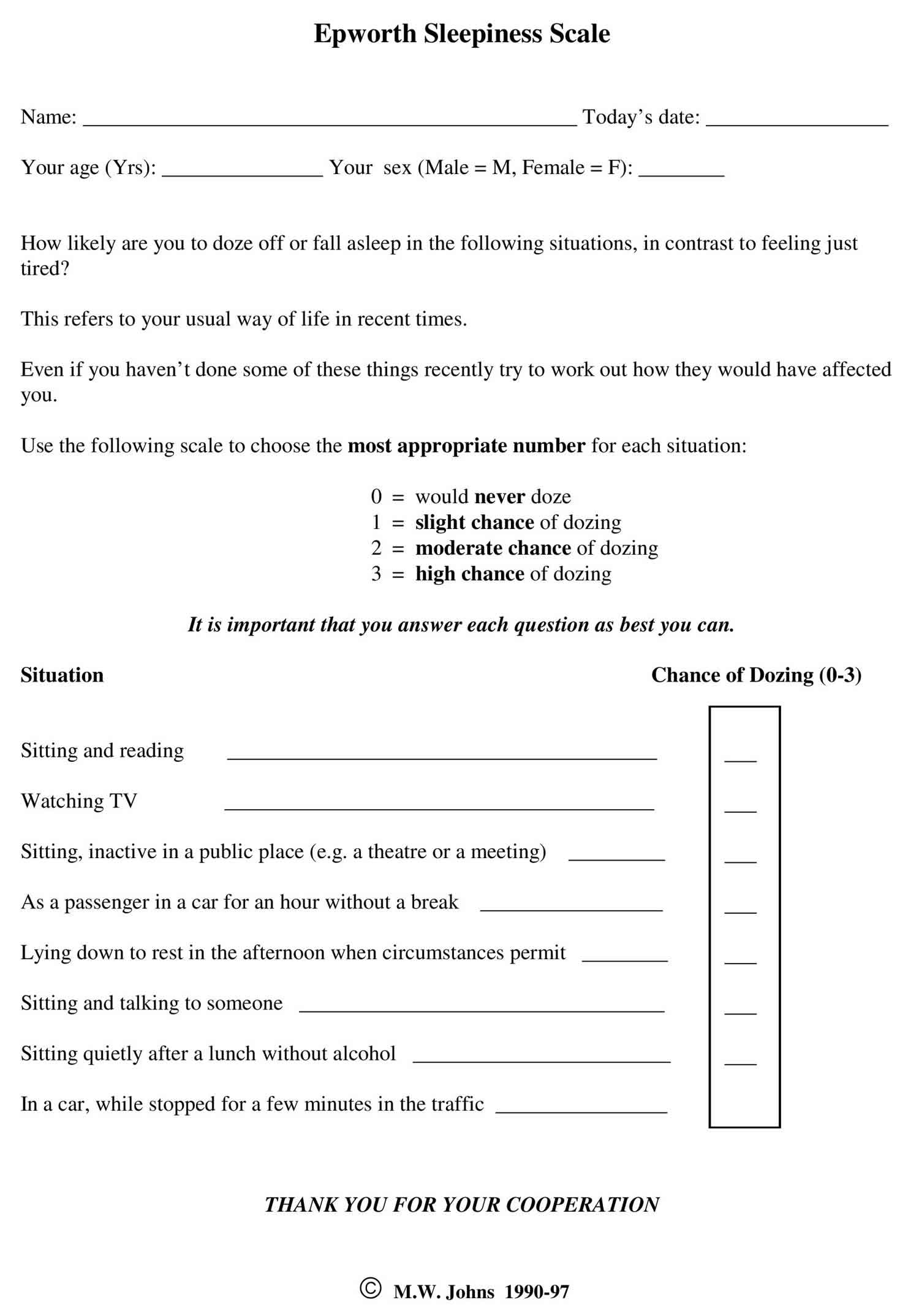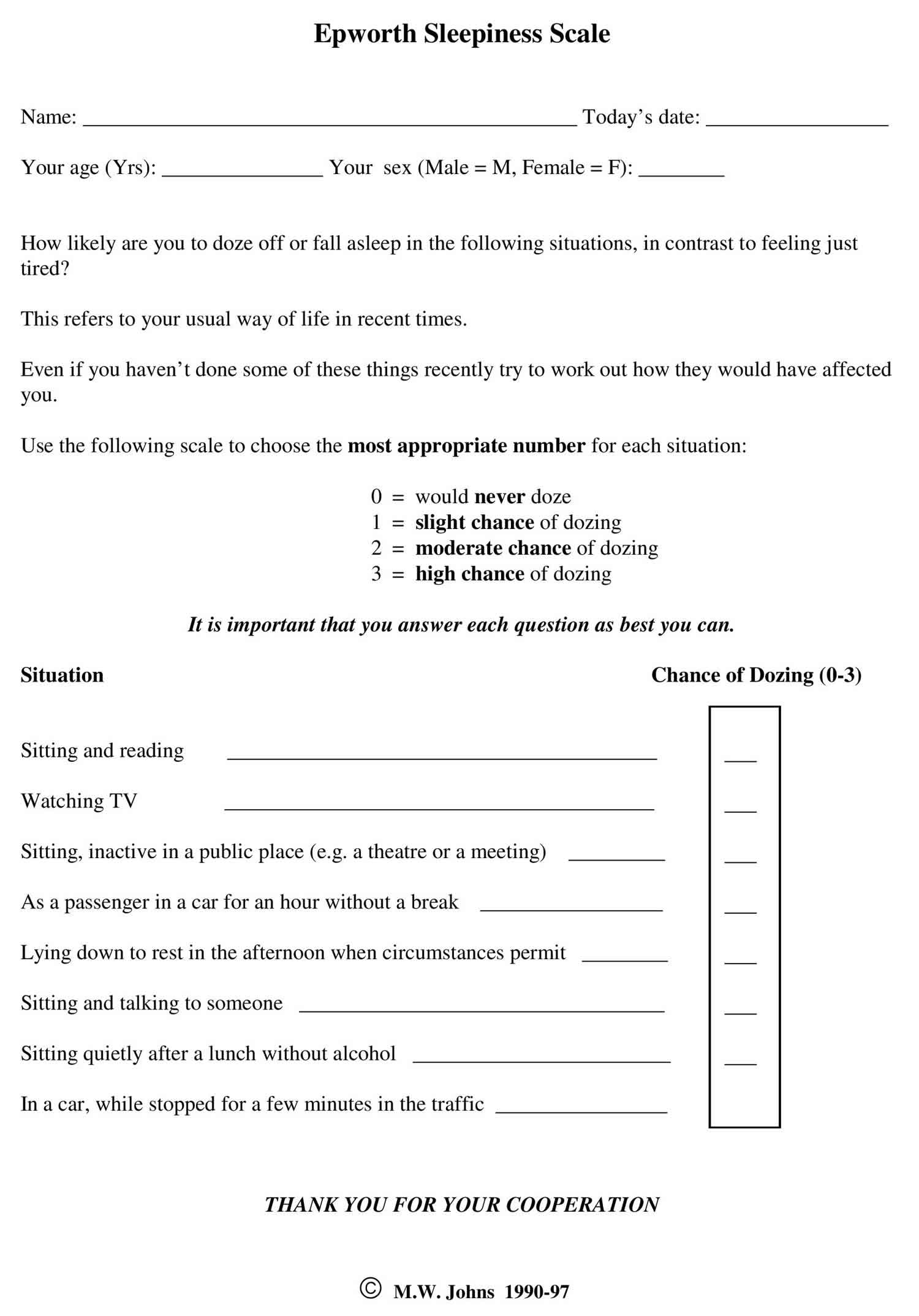Epworth sleepiness scale
Epworth Sleepiness Scale (ESS) is a scale intended to measure ‘daytime sleepiness’ that is measured by use of a very short questionnaire. This can be helpful in diagnosing sleep disorders. Epworth Sleepiness Scale was introduced in 1991 by Dr Murray Johns of Epworth Hospital in Melbourne, Australia and subsequently modified it slightly in 1997.
Epworth Sleepiness Scale is a self-administered questionnaire with 8 questions. The questionnaire asks the subject to rate his or her probability of falling asleep on a scale of increasing probability from 0 to 3 (0 = no chance of dozing 1 = slight chance of dozing 2 = moderate chance of dozing 3 = high chance of dozing) for eight different situations that most people engage in during their daily lives, though not necessarily every day. The scores for the eight questions are added together to obtain a single number. A number in the 0–9 range is considered to be normal while a number in the 10–24 range indicates that expert medical advice should be sought. For instance, scores of 11-15 are shown to indicate the possibility of mild to moderate sleep apnea, where a score of 16 and above indicates the possibility of severe sleep apnea or narcolepsy. Certain questions in the scale were shown to be better predictors of specific sleep disorders, though further tests may be required to provide an accurate diagnosis.
Epworth Sleepiness Scale score
Epworth Sleepiness Scale is a scale intended to measure daytime sleepiness that is measured by use of a very short questionnaire. Epworth Sleepiness Scale can be helpful in diagnosing sleep disorders.
Sitting and reading
- 0 – no chance of dozing
- 1 – slight chance of dozing
- 2 – moderate chance of dozing
- 3 – high chance of dozing
Watching television
- 0 – no chance of dozing
- 1 – slight chance of dozing
- 2 – moderate chance of dozing
- 3 – high chance of dozing
Sitting, inactive in a public place (e.g. a theater or meeting)
- 0 – no chance of dozing
- 1 – slight chance of dozing
- 2 – moderate chance of dozing
- 3 – high chance of dozing
As a passenger in a car for an hour without a break
- 0 – no chance of dozing
- 1 – slight chance of dozing
- 2 – moderate chance of dozing
- 3 – high chance of dozing
Lying down to rest in the afternoon when circumstances permit
- 0 – no chance of dozing
- 1 – slight chance of dozing
- 2 – moderate chance of dozing
- 3 – high chance of dozing
Sitting and talking to someone
- 0 – no chance of dozing
- 1 – slight chance of dozing
- 2 – moderate chance of dozing
- 3 – high chance of dozing
Sitting quietly after a lunch without alcohol
- 0 – no chance of dozing
- 1 – slight chance of dozing
- 2 – moderate chance of dozing
- 3 – high chance of dozing
In a car, while stopped for a few minutes in the traffic
- 0 – no chance of dozing
- 1 – slight chance of dozing
- 2 – moderate chance of dozing
- 3 – high chance of dozing
Add up all the scores and write in the designated “total score box”.
Interpret the results as per the scale below.
- Score: 1- 6 = Enough Sleep
- Score: 7-8 = Tend to be sleepy during the day
- Score: 9- 15 = Very sleepy
- Score: 16+ = Dangerously sleepy
Your Score is less than 9 and in considered normal
Your Score is above 9 and its recommended that you should seek medical advice.
Epworth Sleepiness Scale interpretation
Epworth Sleepiness Scale is a self-administered questionnaire with 8 questions. Respondents are asked to rate, on a 0-3 scale (0 = no chance of dozing 1 = slight chance of dozing 2 = moderate chance of dozing 3 = high chance of dozing), their usual chances of dozing off or falling asleep while engaged in eight different activities. Most people engage in those activities at least occasionally, although not necessarily every day. The Epworth Sleepiness Scale score (the sum of 8 item scores, 0-3) can range from 0 to 24. The higher the Epworth Sleepiness Scale score, the higher that person’s average sleep propensity in daily life, or their ‘daytime sleepiness’. A number in the 0–9 range is considered to be normal while a number in the 10–24 range indicates that expert medical advice should be sought. For instance, scores of 11-15 are shown to indicate the possibility of mild to moderate sleep apnea, where a score of 16 and above indicates the possibility of severe sleep apnea or narcolepsy. Certain questions in the Epworth Sleepiness Scale were shown to be better predictors of specific sleep disorders, though further tests may be required to provide an accurate diagnosis.






